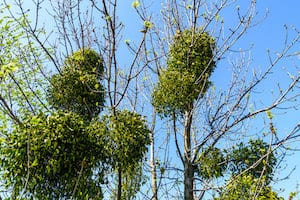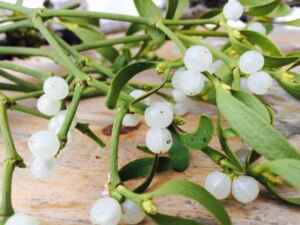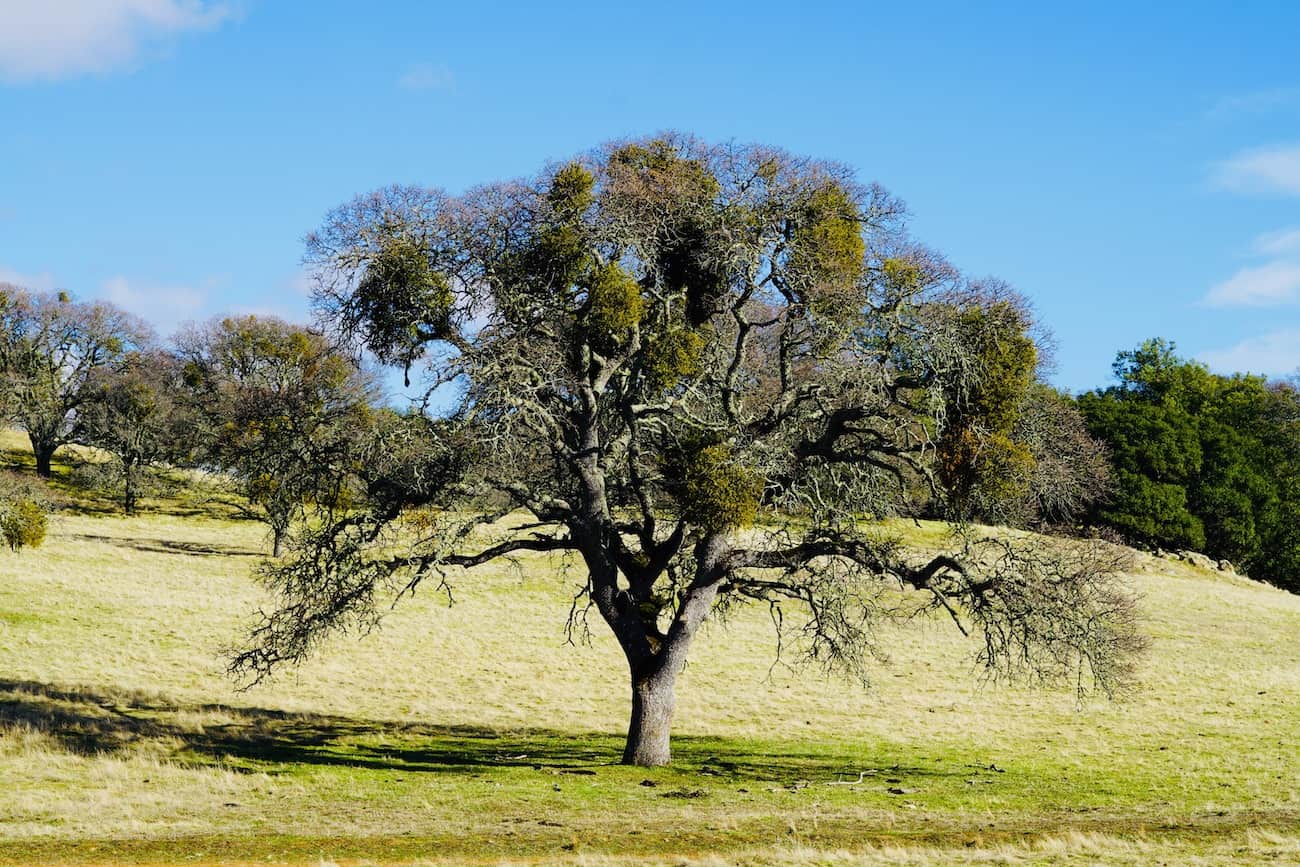Mistletoe is a common plant to see around the holidays. Many people associate the plant with a kiss or a sign of good luck. Some people even put mistletoe on their Christmas trees. Depending on the type of tree you choose to put up for the holidays, can change how mistletoe may affect it.
Is mistletoe good or bad for trees? Mistletoes are parasitic plants that grow upon host trees, typically evergreen trees such as pines or firs of Northern Hemisphere temperate regions. Some types of trees have mistletoe naturally growing and some are placed in hopes that it will help the tree flourish. If properly cared for, the tree and mistletoe can grow harmoniously to produce a unique and beautiful tree.
Mistletoe On The Tree: Good or Bad?
The word ‘mistletoe’ forms part of the Germanic words for “dung” and “twig”, which represent its status in past times as an unwanted parasite growing on manure-rich branches.
The idea of mistletoe no longer is associated with its Germanic root words. It is now a symbol of love and kindness, especially during the holiday season.
Mistletoes’ Affect on Trees
People say mistletoe affects trees because mistletoe takes water and nutrients from the tree. In other words, mistletoe leeches off of the tree.
People also say mistletoe is bad for trees because mistletoe needs to be taken care of so it does not kill the host. Although, depending on if the mistletoe is still alive or producing will determine if it poses a threat to your tree.
Because alive trees are picked to be brought inside and decorated, they tend to have a constant water supply. This will allow the tree to keep its freshness as long as possible and provide nutrients for the tree and mistletoe.
If you find that your tree is not looking as fresh or needs more water, consider reducing the amount of mistletoe on the tree. The type of tree you choose to decorate will determine its ability to grow alongside the mistletoe.
 How Much Mistletoe Would Affect Your Tree
How Much Mistletoe Would Affect Your Tree
Depending on the type of tree you have, there could be varying amounts of mistletoe already growing. Removing them will depend on how much has grown.
If there is only one stem of mistletoe on your tree, then you can just cut it down if you don’t like it. However, if there are several stems worth of mistletoe on your tree, then you need to call an expert before taking anything down to make sure everything is removed.
If mistletoe has been growing on your tree for a very long time, then mistletoe experts would say mistletoe is good because mistletoes kept the tree alive for so long.
But if there is not much mistletoe on your tree, then people would think mistletoes are bad for trees because it means you don’t have many mistletoes to show off and that you do not take care of them properly.
If you find a tree that grows despite having mistletoe, consider keeping the mistletoe on the tree. If you don’t want the hassle of dealing with the mistletoe, it can always be removed later.
Special Instructions For Mistletoe On Your Tree
If you want mistletoe to stop growing on your tree, mistletoe experts would advise you to put something sticky or sharp on it so mistletoes can’t grab onto the bark of your tree.
If You Don’t Want Mistletoe On Your Tree
Cut it at its base; remove all fertile stems; scrape away outer bark, cambium layer, and phloem; treat freshly cleaned area with fungicide (e.g., benomyl, propiconazole) and seal with paint or synthetic rubber.
The Science Behind Mistletoe Growth
Mistletoes are hemiparasitic plants that grow attached to the branches of other plants. A parasitic plant obtains at least some of its nutrients from another living plant. Hemiparasites obtain water and essential nutrients from another plant but also manufacture food themselves via photosynthesis.
Characteristics of Mistletoe
The leaves are oval or egg-shaped with an oblong base. Mistletoes are characterized by having either sessile flowers, which lack a stalk entirely, or staminate flowers borne on long, slender shoots called filaments that grow in clusters among the leaves.
Mistletoes usually flower around Christmas time when people decorate their houses with mistletoe and put it on their trees. It is common to see mistletoe hanging on the branches of Christmas trees inside homes during the holiday season.
 Why We Have Mistletoe On Our Christmas Tree
Why We Have Mistletoe On Our Christmas Tree
Since ancient times mistletoe has been considered a symbol of fertility and life because it does not wilt when it stands alone without any help from other trees. People of the past believed that mistletoe could protect them against evil spirits and bring good luck to homes that had mistletoe hanging on their doors during Christmas time.
The tradition of putting mistletoes above doorways stems back to ancient Scandinavians who believed mistletoe symbolized peace, love, and friendship. They cut mistletoe from oak trees with a golden sickle while saying prayers for peace to whoever was underneath it (the person must not be harmed).
These days mistletoe is commonly used as decoration during the holiday season especially on Christmas trees inside the home or in factories. Most homeowners buy mistletoe manufactured by mistletoe companies because they believe that these are safer than mistletoe picked on mistletoe farms.
Is Mistletoe Good or Bad For Trees?
Indeed, mistletoe does not harm the host tree to which it attaches (although stems, leaves, and branches can be girdled by mistletoe).
However, mistletoe could kill its host tree when mistletoe berries are eaten by birds that then disperse the seeds of mistletoe over long distances through their droppings.
So What Makes Mistletoe Harmful to Trees?
Mistletoes attach to trees using haustoria. These are modified stems that penetrate xylem vessels of host trees resulting in nutrient transfer from one plant to another. If mistletoe is too present in an area, mistletoes could starve the tree of nutrients that it needs to live.
Mistletoe infestation can lead to stunted growth and reduced flower fertility due to nutrient starvation. The mistletoe plant also causes discoloration or spotting on the leaves of trees.
Mistletoe infestation decreases yield, damages woody stems, and causes a decline of older trees resulting in their death which leads to the destruction of host trees over time. As mistletoes grow into larger clumps they compete with other plants for sunlight, water, and soil nutrients eventually killing them and leading to ecological imbalances.
Mistletoe infestation can be prevented by mistletoe removal or mistletoe management. Mistletoe should be removed from trees if it is completely covering the tree’s branches up to 10 inches above the tree stub.
Safely Growing Mistletoe For Your Tree
Removal of mistletoe involves the use of mistletoe knives. These are tools designed for cutting mistletoe, or handsaws that are used to cut mistletoes growing on trees. The base of mistletoes should then be sealed with paint or synthetic rubber to prevent mistletoes from regrowing.
If you hire someone to remove mistletoes using a saw, make sure that the person removes all traces of mistletoe at or below the recommended strip height on your tree.
Mistletoe should also be controlled by growing mistletoe in container gardens instead of mistletoe that is planted on trees. This can help prevent mistletoes from killing trees or causing them to die over time.
You may opt to buy mistletoe man-made products or grow mistletoe in containers so you won’t have to harm mistletoe’s host trees while enjoying its benefits during the festive season.
Mistletoes are currently commercially cultivated for ornamental purposes and these are considered safer compared to wild harvesting of mistletoes. In the mistletoe management process, mistletoes should never be cut from living trees because mistletoes have a higher chance of mistletoe re-growth when mistletoes are cut from living trees.
 How To Decorate With Mistletoe
How To Decorate With Mistletoe
Mistletoe is sold by mistletoe companies that are fertilized with seeds in mistletoe farms before harvesting. The mistletoe’s host trees are not killed in the mistletoe fertilization process. This process creates a safe way for the production of mistletoe to create all the holiday décor you could need.
Mistletoe-producing companies sell mistletoe products such as mistletoe wreaths and garlands. If they don’t make decorations themselves, then they can sell the mistletoe they grow to companies that use them to make holiday decorations.
Many nurseries and plant stores stock up on mistletoe during the holidays to offer a multitude of options. You can put mistletoe on your tree, or the front door, and even hang it in a room for a special touch. If you have not tried, consider putting mistletoe on your next Christmas tree!
This plant will add a pop of color and texture that will give your tree a unique look and feel. Place a mistletoe garland around the tree or along the stairwell to make the festivities flow throughout your house.
For outdoor decorations, start with your front door. A mistletoe wreath will feel like a fresh bouquet right on your door! You could also place a few on your plants if you are careful not to let them overtake your garden. Also, consider adorning them to your mailbox to add festive fun to it!
No matter how you use mistletoe, it will add holiday cheer to any tradition!

